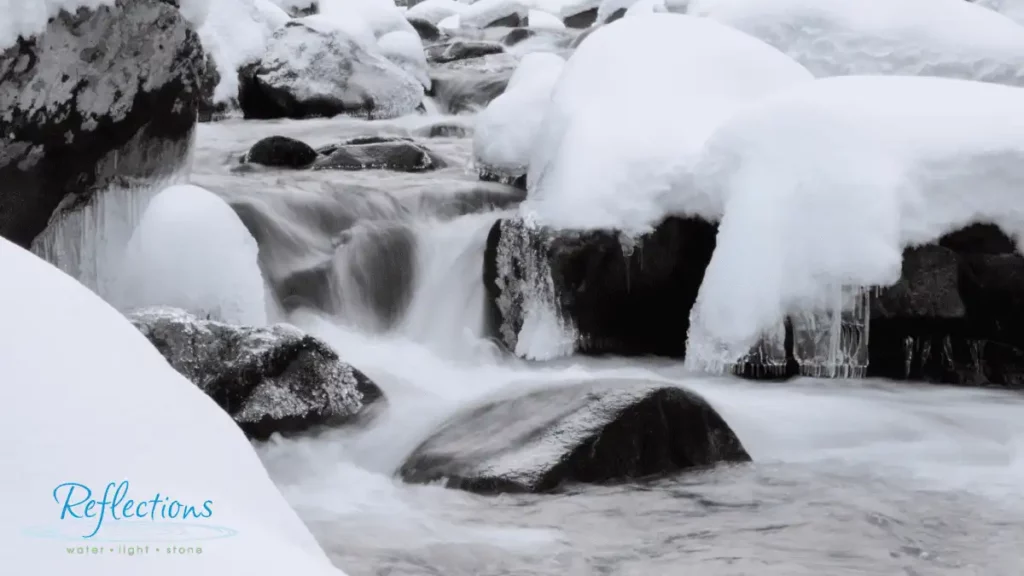Winterizing Your Natural Pool or Koi Pond for Cold Weather
October 19, 2020, 0 CommentsIt’s not even Thanksgiving yet, but with steadily falling temperatures across many parts of the United States, it’s a good idea to start thinking about the rapidly approaching winter months.
For those who have a natural pool or koi pond in their backyard, winter weather prep is even more important to get on top of in early November.
How long does it take for a pond to freeze?
Once freezing temperatures hit, it could take anywhere from 2-4 days for your water feature to freeze depending on how far below freezing the temperature remains.
By preparing now, however, you will ensure the health of your natural pool or koi pond throughout the winter and decrease the amount of maintenance that’s needed after winter passes.

Preparing Your Outdoor Natural Pool for Cold Weather
Natural pools and koi ponds are beautiful and easy-to-maintain additions to any backyard, but they require very specific winter weather preparation protocols. That’s why we’ve created this step-by-step guide to follow when winterizing your pool or pond.
Cold Weather Plant Care
If your natural or koi pond has plants in it, how you prepare them for winter will have a huge impact on how “ready” your landscape feature is to take on colder temperatures.

First, remove any sludge and plant debris from the bottom and surface of the pool or pond. Consider placing pond netting over your body of water to prevent any organic debris from falling in during the winter. Then, figure out which types of plants your pond or pool contains.
Water lilies or lotuses, hardy plants, marginally hardy plants, or tropical plants. Each type of plant correlates to its own unique winter care protocol:
- Water Lilies or Lotuses
Both will survive as long as they are submerged deep enough that they will not freeze solid (usually a few feet). Just make sure to cut back the yellowing leaves first.
- Hardy Plants
As long as they stay submerged in the pond, they can survive even freezing temperatures. Usually, this type of plant does best closer to the surface of the pond or pool.
- Marginally Hardy Plants
This type of plant can survive winter cold, but it will die if its crown freezes. To avoid this, you’ll want to submerge them below the ice/freeze line.
- Tropical Plants
These plants will not survive if left outside during the winter. We recommend that they be brought inside to function as houseplants until the cold temperatures pass.
Cold Weather Koi Care
Koi are hardy fish. They can survive at very low, even freezing temperatures as long as the pond doesn’t freeze solid and maintains a high water quality throughout the winter season. Winter care for koi fish is surprisingly straightforward.

Many of our clients ask us how to winterize koi ponds and keep their fish healthy. To keep your koi at optimal health, make sure you:
- Start feeding your koi fish cold water fish food when the water temperature drops below 59°F
- Reduce the amount of food you feed them as the temperature continues to drop. By the time the water temperature is consistently below 48°F, you should stop feeding the koi because their metabolism will be too slow to digest the food
- Add a cold water beneficial bacteria to the water to ensure adequate water quality
- Consider adding pond salt
If the top of the pond freezes over, it is important to maintain a hole in the solid surface. This will allow oxygen to flow into the pond, while noxious gasses can flow out. To maintain an adequate hole in the ice, we recommend using a pond heater/de-icer.
Remove the Pump for Winter
If you have a pump in your natural pool or koi pond, it’s probably best to remove it, clean it thoroughly, and store it for winter.
Direct Drive Style Pumps
These pumps should be stored in water and protected from freezing to keep the seals moist. If you have a magnetic drive or asynchronous pump, it can be stored in any dry place.
Winterizing Lights and Filters
Most natural pool and koi pond filters will survive the winter cold, but if you have a pressurized filter, you’ll want to remove and store it until spring.
Make sure that filter pads and bio-media are cleaned and stored. UV lights should be unplugged, removed, cleaned thoroughly, and stored for the winter, too.
Waterfall Care in for Cold Weather

For customers who live in climates that experience below-freezing temperatures, we always recommend they shut down the natural pool’s waterfalls during late fall before freezing temperatures become a problem.
Without shutting down the waterfall, ice dams can divert water out of the pool or pond. These ice dams can inadvertently drain their beautiful backyard structure.
Reflections Water Gardens
At Reflections, we know how big of an investment in a natural pool or koi pond can be, and our goal is to help homeowners understand how to protect and care for that investment. If you have any additional questions about winterizing your koi pond or preparing your natural pool for the upcoming winter weather, contact us today.


0 Comments